Leadership and Management Theories Applied: Ford Vietnam Company
VerifiedAdded on 2022/04/18
|18
|4184
|26
Report
AI Summary
This report delves into the distinctions between leaders and managers, analyzing their roles and characteristics within the context of Ford Vietnam Company. It begins by defining leadership and management, contrasting their functions and traits, and then applies management and leadership theories to evaluate the performance of Mr. Quang, a production manager. The report examines key management functions like planning, organizing, commanding, coordinating, and controlling, assessing Mr. Quang's effectiveness in each area. It highlights discrepancies between Mr. Quang's management style and the company's emphasis on democratic principles, particularly concerning employee empowerment and feedback. Furthermore, the report explores various leadership roles, such as being a representative of the organization, integrating goals, and soliciting support. The analysis incorporates classical, behavioral, and contingency approaches to management, providing a comprehensive overview of leadership and management principles within the automotive manufacturing setting.
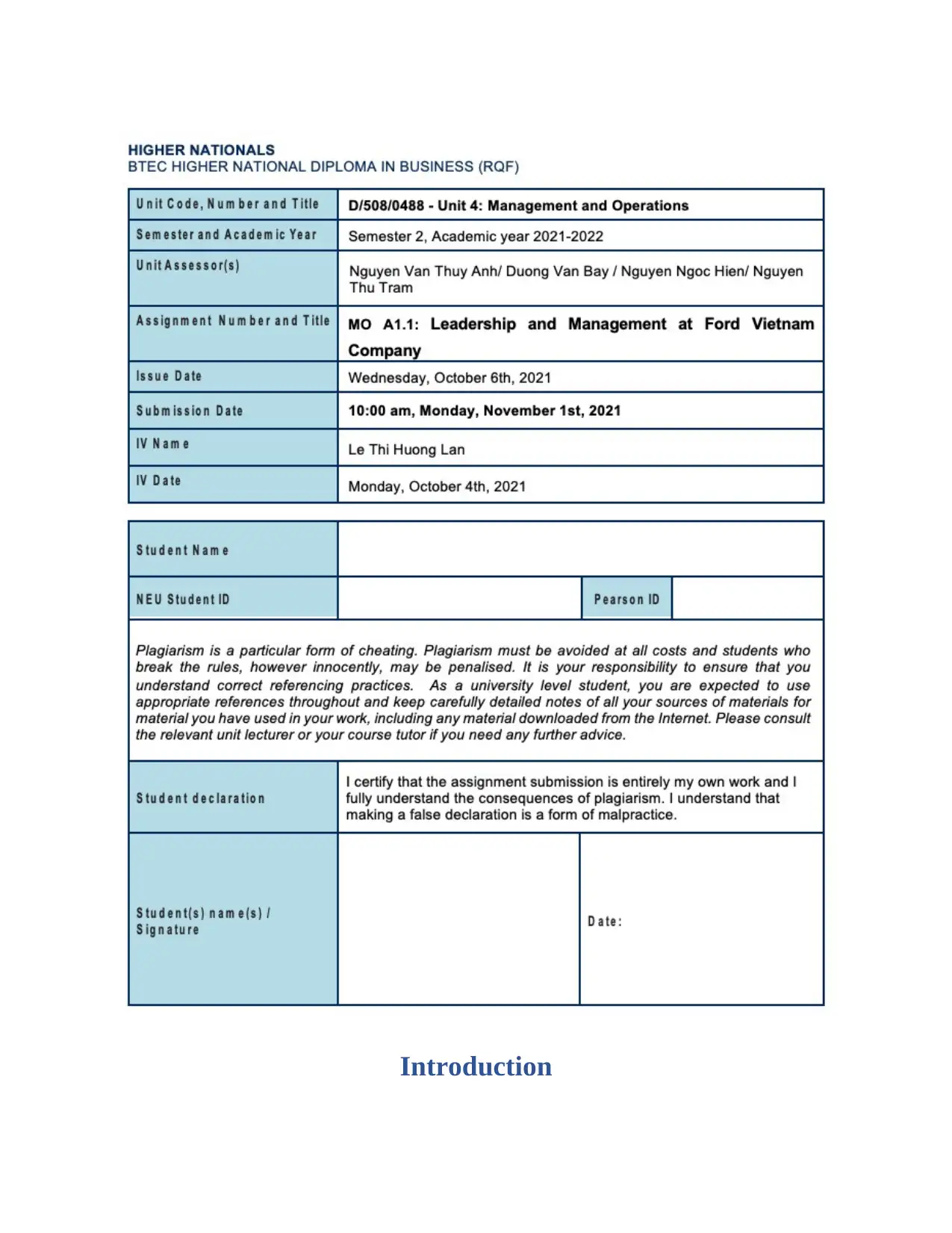
Introduction
Paraphrase This Document
Need a fresh take? Get an instant paraphrase of this document with our AI Paraphraser
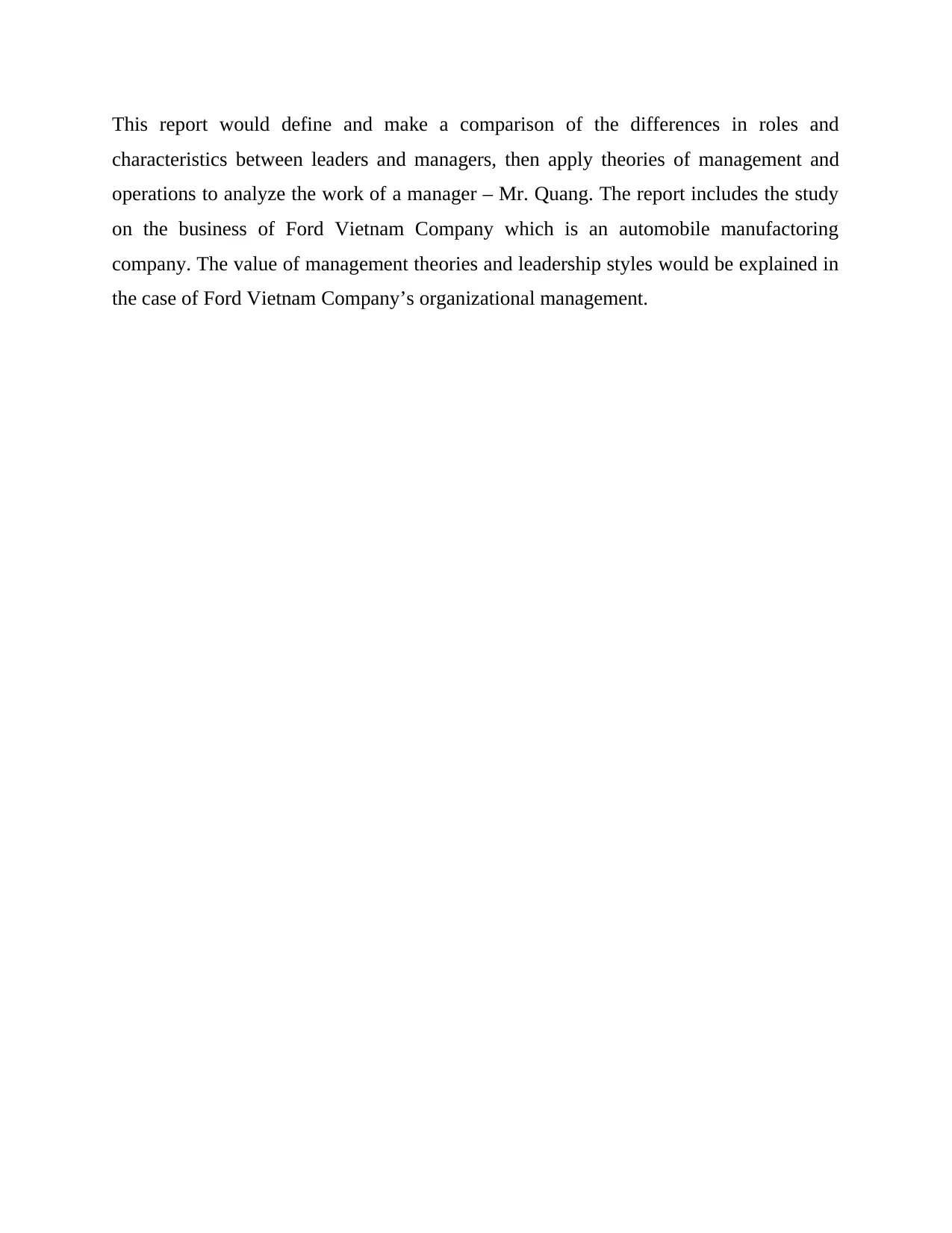
This report would define and make a comparison of the differences in roles and
characteristics between leaders and managers, then apply theories of management and
operations to analyze the work of a manager – Mr. Quang. The report includes the study
on the business of Ford Vietnam Company which is an automobile manufactoring
company. The value of management theories and leadership styles would be explained in
the case of Ford Vietnam Company’s organizational management.
characteristics between leaders and managers, then apply theories of management and
operations to analyze the work of a manager – Mr. Quang. The report includes the study
on the business of Ford Vietnam Company which is an automobile manufactoring
company. The value of management theories and leadership styles would be explained in
the case of Ford Vietnam Company’s organizational management.
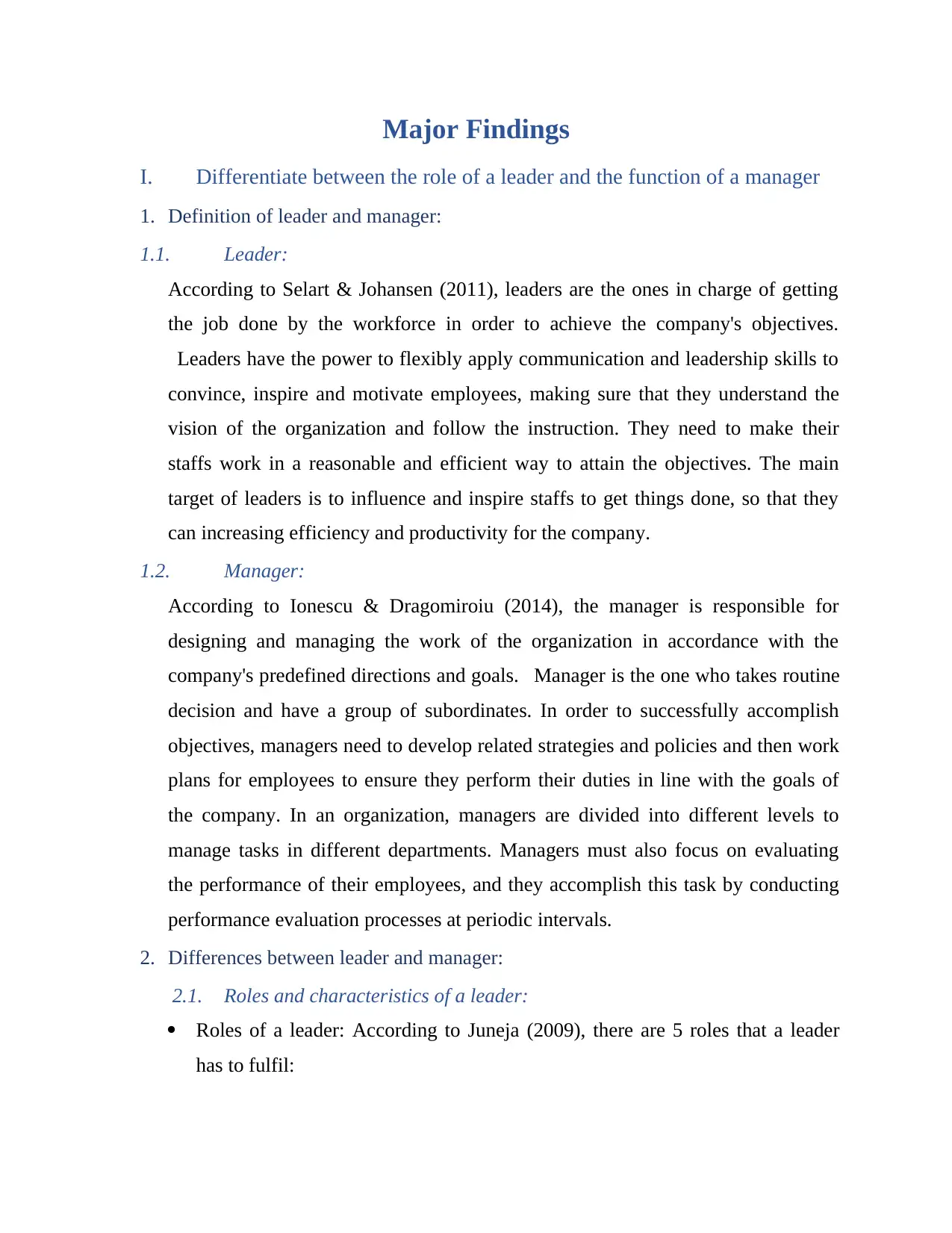
Major Findings
I. Differentiate between the role of a leader and the function of a manager
1. Definition of leader and manager:
1.1. Leader:
According to Selart & Johansen (2011), leaders are the ones in charge of getting
the job done by the workforce in order to achieve the company's objectives.
“Leaders have the power to flexibly apply communication and leadership skills to
convince, inspire and motivate employees, making sure that they understand the
vision of the organization and follow the instruction. They need to make their
staffs work in a reasonable and efficient way to attain the objectives. The main
target of leaders is to influence and inspire staffs to get things done, so that they
can increasing efficiency and productivity for the company.”
1.2. Manager:
According to Ionescu & Dragomiroiu (2014), the manager is responsible for
designing and managing the work of the organization in accordance with the
company's predefined directions and goals. “Manager is the one who takes routine
decision and have a group of subordinates. In order to successfully accomplish
objectives, managers need to develop related strategies and policies and then work
plans for employees to ensure they perform their duties in line with the goals of
the company. In an organization, managers are divided into different levels to
manage tasks in different departments. Managers must also focus on evaluating
the performance of their employees, and they accomplish this task by conducting
performance evaluation processes at periodic intervals.”
2. Differences between leader and manager:
2.1. Roles and characteristics of a leader:
Roles of a leader: According to Juneja (2009), there are 5 roles that a leader
has to fulfil:
I. Differentiate between the role of a leader and the function of a manager
1. Definition of leader and manager:
1.1. Leader:
According to Selart & Johansen (2011), leaders are the ones in charge of getting
the job done by the workforce in order to achieve the company's objectives.
“Leaders have the power to flexibly apply communication and leadership skills to
convince, inspire and motivate employees, making sure that they understand the
vision of the organization and follow the instruction. They need to make their
staffs work in a reasonable and efficient way to attain the objectives. The main
target of leaders is to influence and inspire staffs to get things done, so that they
can increasing efficiency and productivity for the company.”
1.2. Manager:
According to Ionescu & Dragomiroiu (2014), the manager is responsible for
designing and managing the work of the organization in accordance with the
company's predefined directions and goals. “Manager is the one who takes routine
decision and have a group of subordinates. In order to successfully accomplish
objectives, managers need to develop related strategies and policies and then work
plans for employees to ensure they perform their duties in line with the goals of
the company. In an organization, managers are divided into different levels to
manage tasks in different departments. Managers must also focus on evaluating
the performance of their employees, and they accomplish this task by conducting
performance evaluation processes at periodic intervals.”
2. Differences between leader and manager:
2.1. Roles and characteristics of a leader:
Roles of a leader: According to Juneja (2009), there are 5 roles that a leader
has to fulfil:
⊘ This is a preview!⊘
Do you want full access?
Subscribe today to unlock all pages.

Trusted by 1+ million students worldwide
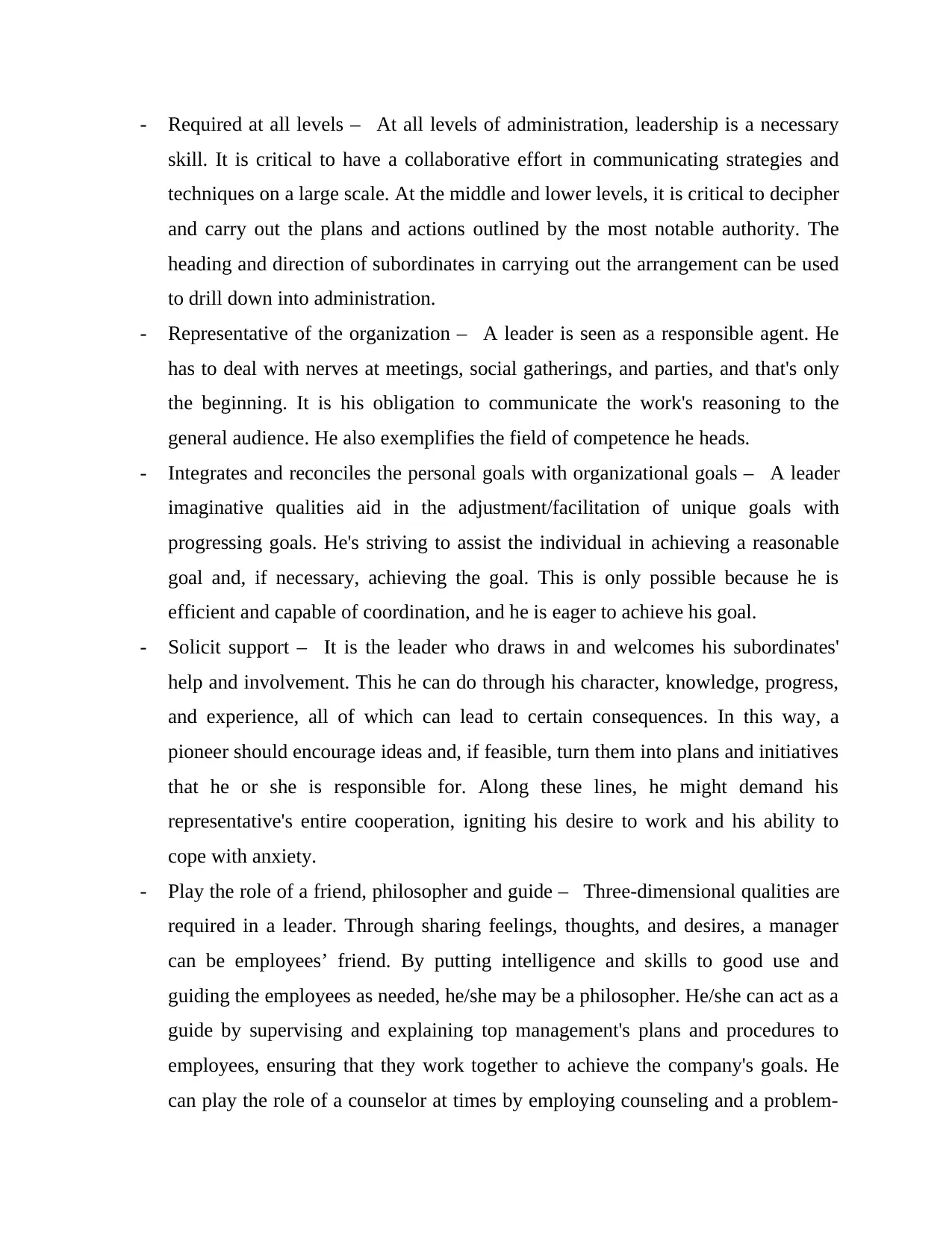
- Required at all levels – “At all levels of administration, leadership is a necessary
skill. It is critical to have a collaborative effort in communicating strategies and
techniques on a large scale. At the middle and lower levels, it is critical to decipher
and carry out the plans and actions outlined by the most notable authority. The
heading and direction of subordinates in carrying out the arrangement can be used
to drill down into administration.”
- Representative of the organization – “A leader is seen as a responsible agent. He
has to deal with nerves at meetings, social gatherings, and parties, and that's only
the beginning. It is his obligation to communicate the work's reasoning to the
general audience. He also exemplifies the field of competence he heads.”
- Integrates and reconciles the personal goals with organizational goals – “A leader
imaginative qualities aid in the adjustment/facilitation of unique goals with
progressing goals. He's striving to assist the individual in achieving a reasonable
goal and, if necessary, achieving the goal. This is only possible because he is
efficient and capable of coordination, and he is eager to achieve his goal.”
- Solicit support – “It is the leader who draws in and welcomes his subordinates'
help and involvement. This he can do through his character, knowledge, progress,
and experience, all of which can lead to certain consequences. In this way, a
pioneer should encourage ideas and, if feasible, turn them into plans and initiatives
that he or she is responsible for. Along these lines, he might demand his
representative's entire cooperation, igniting his desire to work and his ability to
cope with anxiety.”
- Play the role of a friend, philosopher and guide – “Three-dimensional qualities are
required in a leader. Through sharing feelings, thoughts, and desires, a manager
can be employees’ friend. By putting intelligence and skills to good use and
guiding the employees as needed, he/she may be a philosopher. He/she can act as a
guide by supervising and explaining top management's plans and procedures to
employees, ensuring that they work together to achieve the company's goals. He
can play the role of a counselor at times by employing counseling and a problem-
skill. It is critical to have a collaborative effort in communicating strategies and
techniques on a large scale. At the middle and lower levels, it is critical to decipher
and carry out the plans and actions outlined by the most notable authority. The
heading and direction of subordinates in carrying out the arrangement can be used
to drill down into administration.”
- Representative of the organization – “A leader is seen as a responsible agent. He
has to deal with nerves at meetings, social gatherings, and parties, and that's only
the beginning. It is his obligation to communicate the work's reasoning to the
general audience. He also exemplifies the field of competence he heads.”
- Integrates and reconciles the personal goals with organizational goals – “A leader
imaginative qualities aid in the adjustment/facilitation of unique goals with
progressing goals. He's striving to assist the individual in achieving a reasonable
goal and, if necessary, achieving the goal. This is only possible because he is
efficient and capable of coordination, and he is eager to achieve his goal.”
- Solicit support – “It is the leader who draws in and welcomes his subordinates'
help and involvement. This he can do through his character, knowledge, progress,
and experience, all of which can lead to certain consequences. In this way, a
pioneer should encourage ideas and, if feasible, turn them into plans and initiatives
that he or she is responsible for. Along these lines, he might demand his
representative's entire cooperation, igniting his desire to work and his ability to
cope with anxiety.”
- Play the role of a friend, philosopher and guide – “Three-dimensional qualities are
required in a leader. Through sharing feelings, thoughts, and desires, a manager
can be employees’ friend. By putting intelligence and skills to good use and
guiding the employees as needed, he/she may be a philosopher. He/she can act as a
guide by supervising and explaining top management's plans and procedures to
employees, ensuring that they work together to achieve the company's goals. He
can play the role of a counselor at times by employing counseling and a problem-
Paraphrase This Document
Need a fresh take? Get an instant paraphrase of this document with our AI Paraphraser
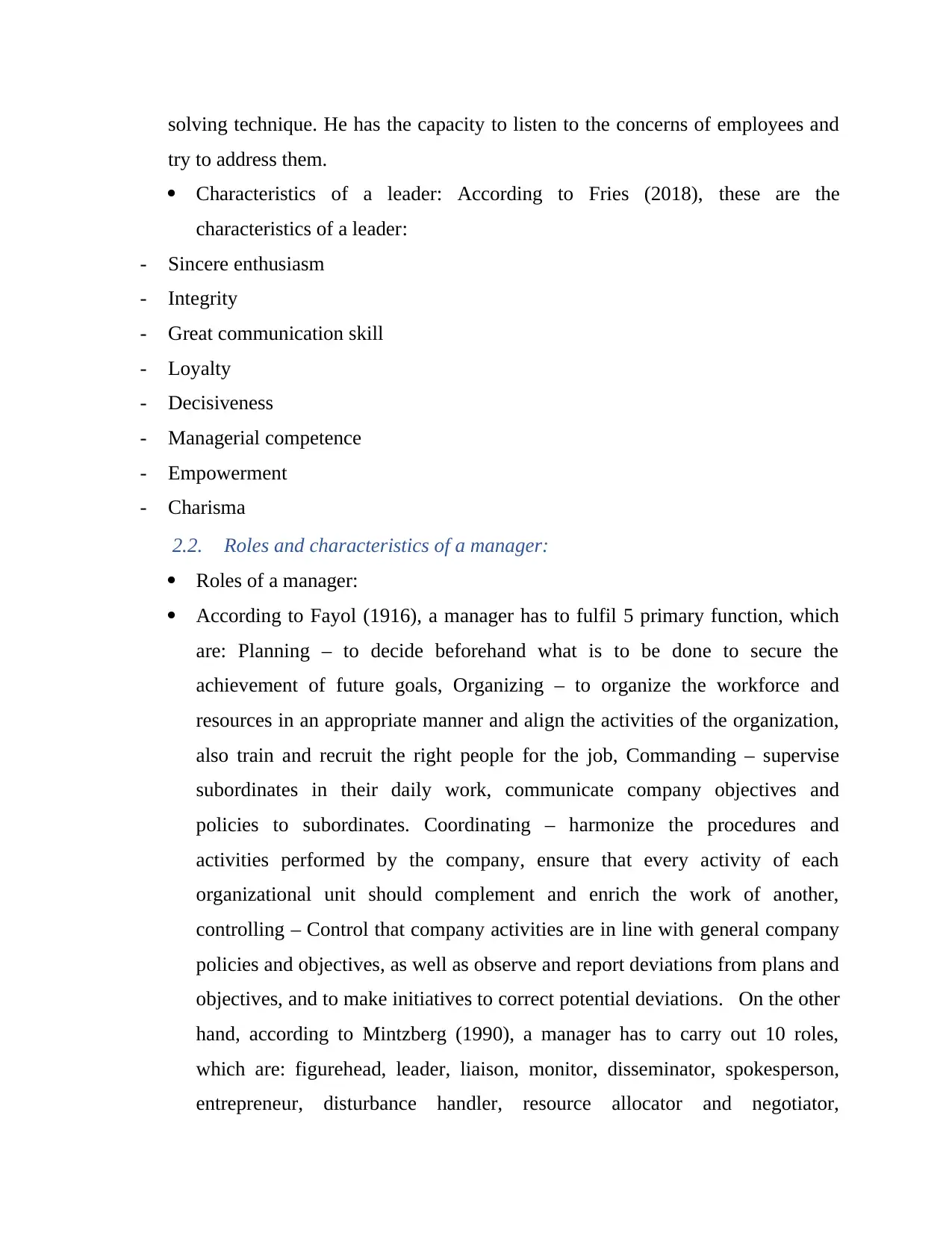
solving technique. He has the capacity to listen to the concerns of employees and
try to address them."
Characteristics of a leader: According to Fries (2018), these are the
characteristics of a leader:
- Sincere enthusiasm
- Integrity
- Great communication skill
- Loyalty
- Decisiveness
- Managerial competence
- Empowerment
- Charisma
2.2. Roles and characteristics of a manager:
Roles of a manager:
According to Fayol (1916), a manager has to fulfil 5 primary function, which
are: Planning – to decide beforehand what is to be done to secure the
achievement of future goals, Organizing – to organize the workforce and
resources in an appropriate manner and align the activities of the organization,
also train and recruit the right people for the job, Commanding – supervise
subordinates in their daily work, communicate company objectives and
policies to subordinates. Coordinating – harmonize the procedures and
activities performed by the company, ensure that every activity of each
organizational unit should complement and enrich the work of another,
controlling – Control that company activities are in line with general company
policies and objectives, as well as observe and report deviations from plans and
objectives, and to make initiatives to correct potential deviations. “On the other
hand, according to Mintzberg (1990), a manager has to carry out 10 roles,
which are: figurehead, leader, liaison, monitor, disseminator, spokesperson,
entrepreneur, disturbance handler, resource allocator and negotiator,
try to address them."
Characteristics of a leader: According to Fries (2018), these are the
characteristics of a leader:
- Sincere enthusiasm
- Integrity
- Great communication skill
- Loyalty
- Decisiveness
- Managerial competence
- Empowerment
- Charisma
2.2. Roles and characteristics of a manager:
Roles of a manager:
According to Fayol (1916), a manager has to fulfil 5 primary function, which
are: Planning – to decide beforehand what is to be done to secure the
achievement of future goals, Organizing – to organize the workforce and
resources in an appropriate manner and align the activities of the organization,
also train and recruit the right people for the job, Commanding – supervise
subordinates in their daily work, communicate company objectives and
policies to subordinates. Coordinating – harmonize the procedures and
activities performed by the company, ensure that every activity of each
organizational unit should complement and enrich the work of another,
controlling – Control that company activities are in line with general company
policies and objectives, as well as observe and report deviations from plans and
objectives, and to make initiatives to correct potential deviations. “On the other
hand, according to Mintzberg (1990), a manager has to carry out 10 roles,
which are: figurehead, leader, liaison, monitor, disseminator, spokesperson,
entrepreneur, disturbance handler, resource allocator and negotiator,
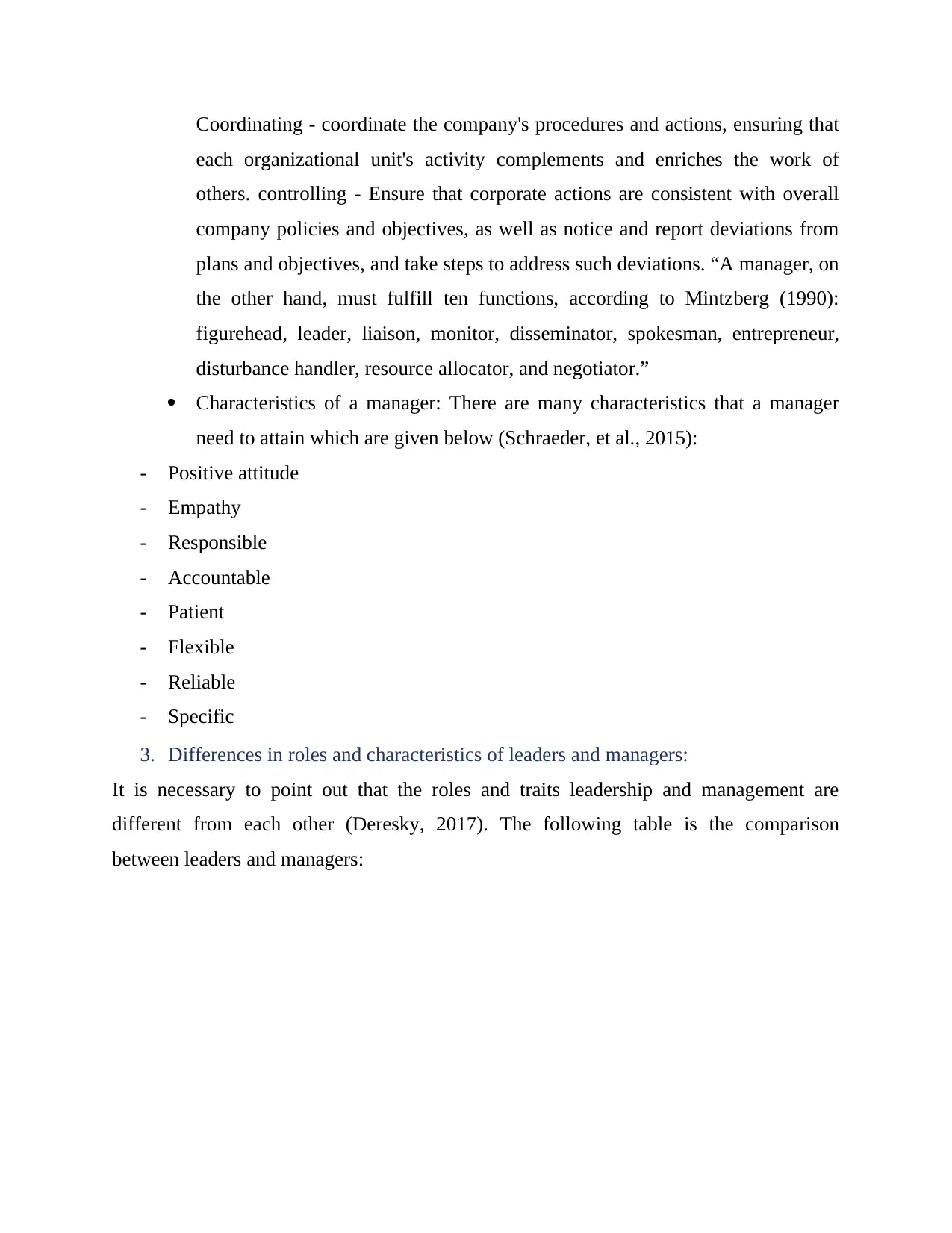
Coordinating - coordinate the company's procedures and actions, ensuring that
each organizational unit's activity complements and enriches the work of
others. controlling - Ensure that corporate actions are consistent with overall
company policies and objectives, as well as notice and report deviations from
plans and objectives, and take steps to address such deviations. “A manager, on
the other hand, must fulfill ten functions, according to Mintzberg (1990):
figurehead, leader, liaison, monitor, disseminator, spokesman, entrepreneur,
disturbance handler, resource allocator, and negotiator.”
Characteristics of a manager: There are many characteristics that a manager
need to attain which are given below (Schraeder, et al., 2015):
- Positive attitude
- Empathy
- Responsible
- Accountable
- Patient
- Flexible
- Reliable
- Specific
3. Differences in roles and characteristics of leaders and managers:
It is necessary to point out that the roles and traits leadership and management are
different from each other (Deresky, 2017). The following table is the comparison
between leaders and managers:
each organizational unit's activity complements and enriches the work of
others. controlling - Ensure that corporate actions are consistent with overall
company policies and objectives, as well as notice and report deviations from
plans and objectives, and take steps to address such deviations. “A manager, on
the other hand, must fulfill ten functions, according to Mintzberg (1990):
figurehead, leader, liaison, monitor, disseminator, spokesman, entrepreneur,
disturbance handler, resource allocator, and negotiator.”
Characteristics of a manager: There are many characteristics that a manager
need to attain which are given below (Schraeder, et al., 2015):
- Positive attitude
- Empathy
- Responsible
- Accountable
- Patient
- Flexible
- Reliable
- Specific
3. Differences in roles and characteristics of leaders and managers:
It is necessary to point out that the roles and traits leadership and management are
different from each other (Deresky, 2017). The following table is the comparison
between leaders and managers:
⊘ This is a preview!⊘
Do you want full access?
Subscribe today to unlock all pages.

Trusted by 1+ million students worldwide

4. Discuss a range of theories
In the early 19th century, the First Industrial Revolution took place. The characteristic of
this industrial revolution is the use of steam power. By the middle of the 19th century,
machines gradually replaced human labor. Most of the machinery used steam engines and
led to a sudden increase in labor productivity. The productivity of machines increased
rapidly, much higher than that of humans, causing a disparity in productivity in
production. This time. The management of people has not kept pace with the
development of machines. For that reason, many economists have begun to focus on
In the early 19th century, the First Industrial Revolution took place. The characteristic of
this industrial revolution is the use of steam power. By the middle of the 19th century,
machines gradually replaced human labor. Most of the machinery used steam engines and
led to a sudden increase in labor productivity. The productivity of machines increased
rapidly, much higher than that of humans, causing a disparity in productivity in
production. This time. The management of people has not kept pace with the
development of machines. For that reason, many economists have begun to focus on
Paraphrase This Document
Need a fresh take? Get an instant paraphrase of this document with our AI Paraphraser
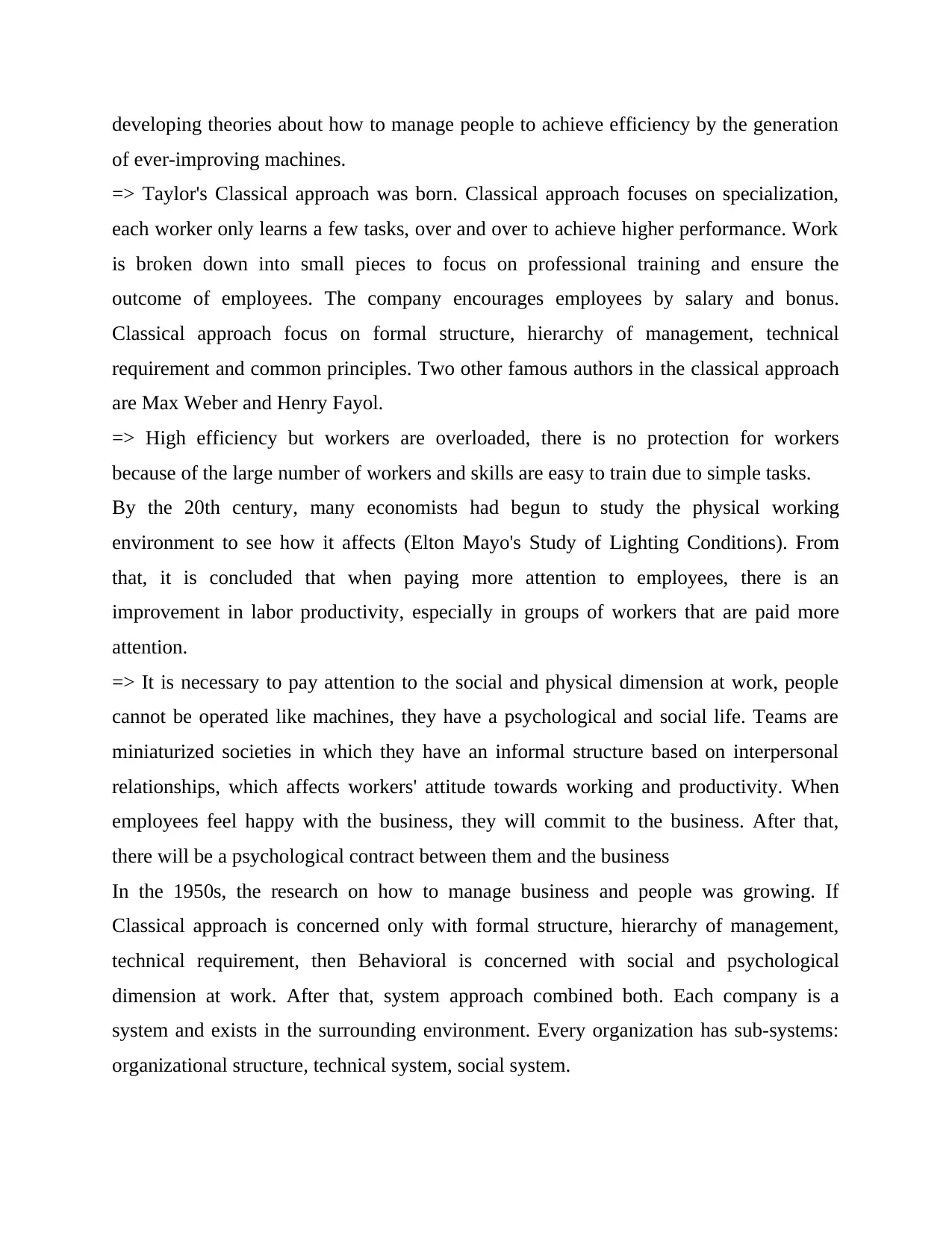
developing theories about how to manage people to achieve efficiency by the generation
of ever-improving machines.
=> Taylor's Classical approach was born. Classical approach focuses on specialization,
each worker only learns a few tasks, over and over to achieve higher performance. Work
is broken down into small pieces to focus on professional training and ensure the
outcome of employees. The company encourages employees by salary and bonus.
Classical approach focus on formal structure, hierarchy of management, technical
requirement and common principles. Two other famous authors in the classical approach
are Max Weber and Henry Fayol.
=> High efficiency but workers are overloaded, there is no protection for workers
because of the large number of workers and skills are easy to train due to simple tasks.
By the 20th century, many economists had begun to study the physical working
environment to see how it affects (Elton Mayo's Study of Lighting Conditions). From
that, it is concluded that when paying more attention to employees, there is an
improvement in labor productivity, especially in groups of workers that are paid more
attention.
=> It is necessary to pay attention to the social and physical dimension at work, people
cannot be operated like machines, they have a psychological and social life. Teams are
miniaturized societies in which they have an informal structure based on interpersonal
relationships, which affects workers' attitude towards working and productivity. When
employees feel happy with the business, they will commit to the business. After that,
there will be a psychological contract between them and the business
In the 1950s, the research on how to manage business and people was growing. If
Classical approach is concerned only with formal structure, hierarchy of management,
technical requirement, then Behavioral is concerned with social and psychological
dimension at work. After that, system approach combined both. Each company is a
system and exists in the surrounding environment. Every organization has sub-systems:
organizational structure, technical system, social system.
of ever-improving machines.
=> Taylor's Classical approach was born. Classical approach focuses on specialization,
each worker only learns a few tasks, over and over to achieve higher performance. Work
is broken down into small pieces to focus on professional training and ensure the
outcome of employees. The company encourages employees by salary and bonus.
Classical approach focus on formal structure, hierarchy of management, technical
requirement and common principles. Two other famous authors in the classical approach
are Max Weber and Henry Fayol.
=> High efficiency but workers are overloaded, there is no protection for workers
because of the large number of workers and skills are easy to train due to simple tasks.
By the 20th century, many economists had begun to study the physical working
environment to see how it affects (Elton Mayo's Study of Lighting Conditions). From
that, it is concluded that when paying more attention to employees, there is an
improvement in labor productivity, especially in groups of workers that are paid more
attention.
=> It is necessary to pay attention to the social and physical dimension at work, people
cannot be operated like machines, they have a psychological and social life. Teams are
miniaturized societies in which they have an informal structure based on interpersonal
relationships, which affects workers' attitude towards working and productivity. When
employees feel happy with the business, they will commit to the business. After that,
there will be a psychological contract between them and the business
In the 1950s, the research on how to manage business and people was growing. If
Classical approach is concerned only with formal structure, hierarchy of management,
technical requirement, then Behavioral is concerned with social and psychological
dimension at work. After that, system approach combined both. Each company is a
system and exists in the surrounding environment. Every organization has sub-systems:
organizational structure, technical system, social system.
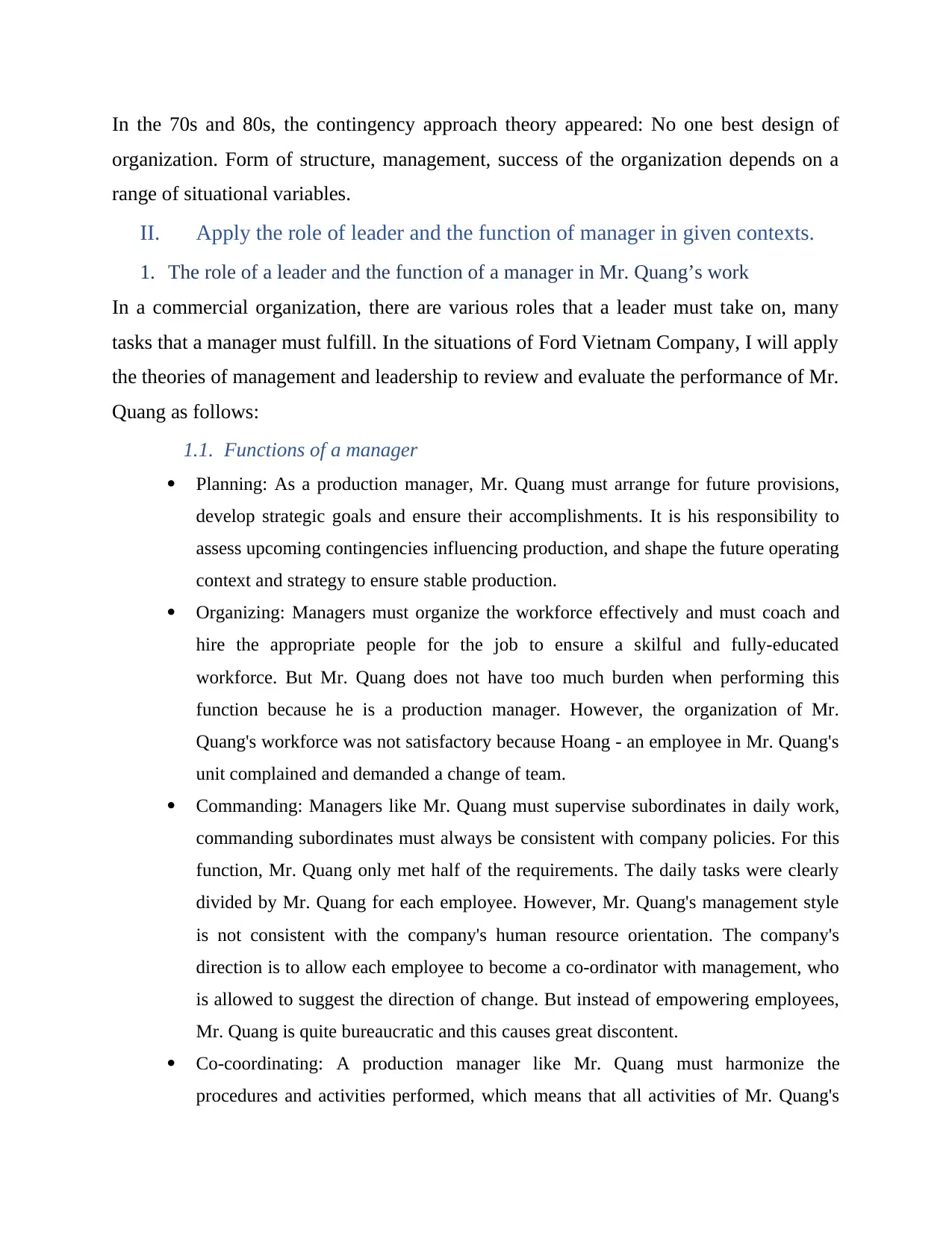
In the 70s and 80s, the contingency approach theory appeared: No one best design of
organization. Form of structure, management, success of the organization depends on a
range of situational variables.
II. Apply.the.role.of.leader.and.the.function.of.manager.in.given.contexts.
1. The.role.of.a.leader.and.the.function.of.a.manager.in.Mr. Quang’s work
In a commercial organization, there are various roles that a leader must take on, many
tasks that a manager must fulfill. In the situations of Ford Vietnam Company, I will apply
the theories of management and leadership to review and evaluate the performance of Mr.
Quang as follows:
1.1. Functions of a manager
Planning: As a production manager, Mr. Quang must arrange for future provisions,
develop strategic goals and ensure their accomplishments. It is his responsibility to
assess upcoming contingencies influencing production, and shape the future operating
context and strategy to ensure stable production.
Organizing: Managers must organize the workforce effectively and must coach and
hire the appropriate people for the job to ensure a skilful and fully-educated
workforce. But Mr. Quang does not have too much burden when performing this
function because he is a production manager. However, the organization of Mr.
Quang's workforce was not satisfactory because Hoang - an employee in Mr. Quang's
unit complained and demanded a change of team.
Commanding: Managers like Mr. Quang must supervise subordinates in daily work,
commanding subordinates must always be consistent with company policies. For this
function, Mr. Quang only met half of the requirements. The daily tasks were clearly
divided by Mr. Quang for each employee. However, Mr. Quang's management style
is not consistent with the company's human resource orientation. The company's
direction is to allow each employee to become a co-ordinator with management, who
is allowed to suggest the direction of change. But instead of empowering employees,
Mr. Quang is quite bureaucratic and this causes great discontent.
Co-coordinating: A production manager like Mr. Quang must harmonize the
procedures and activities performed, which means that all activities of Mr. Quang's
organization. Form of structure, management, success of the organization depends on a
range of situational variables.
II. Apply.the.role.of.leader.and.the.function.of.manager.in.given.contexts.
1. The.role.of.a.leader.and.the.function.of.a.manager.in.Mr. Quang’s work
In a commercial organization, there are various roles that a leader must take on, many
tasks that a manager must fulfill. In the situations of Ford Vietnam Company, I will apply
the theories of management and leadership to review and evaluate the performance of Mr.
Quang as follows:
1.1. Functions of a manager
Planning: As a production manager, Mr. Quang must arrange for future provisions,
develop strategic goals and ensure their accomplishments. It is his responsibility to
assess upcoming contingencies influencing production, and shape the future operating
context and strategy to ensure stable production.
Organizing: Managers must organize the workforce effectively and must coach and
hire the appropriate people for the job to ensure a skilful and fully-educated
workforce. But Mr. Quang does not have too much burden when performing this
function because he is a production manager. However, the organization of Mr.
Quang's workforce was not satisfactory because Hoang - an employee in Mr. Quang's
unit complained and demanded a change of team.
Commanding: Managers like Mr. Quang must supervise subordinates in daily work,
commanding subordinates must always be consistent with company policies. For this
function, Mr. Quang only met half of the requirements. The daily tasks were clearly
divided by Mr. Quang for each employee. However, Mr. Quang's management style
is not consistent with the company's human resource orientation. The company's
direction is to allow each employee to become a co-ordinator with management, who
is allowed to suggest the direction of change. But instead of empowering employees,
Mr. Quang is quite bureaucratic and this causes great discontent.
Co-coordinating: A production manager like Mr. Quang must harmonize the
procedures and activities performed, which means that all activities of Mr. Quang's
⊘ This is a preview!⊘
Do you want full access?
Subscribe today to unlock all pages.

Trusted by 1+ million students worldwide

unit must complement and enrich the work of the unit. is different. This is extremely
necessary for the production unit that Mr. Quang is managing.
Controlling: Mr. Quang needs to control the appropriateness of team activities, and he
also needs to scrutinize and inform deviations from plans and goals and then take
initiatives to rectify them. correct potential deviations. Mr. Quang is controlling the
daily activities of employees very well, but this control has been overdone. One
employee reported that they did not have the opportunity to swap jobs with someone
else. Another employee also said that it is not free to ask questions and suggest
improvements. Thus, the control function of Mr. Quang is not consistent with the
company's policy.
1.2. Role.of.a.leader
Required.at.all.levels – Mr. Quang's position is a production manager which
belongs to the middle levels, it is critical to decipher and carry out the plans and
actions outlined by the most notable authority. However, when the CEO of Ford
emphasizes the democratic management, Mr.Quang leadership style is more like
autocratic. Besides, a leader must also learn through the guidance and advice of
subordinates. In Mr. Quang's case, subordinates are not even free to ask questions
and suggest improvements.
Representative of the organization – This role is not shown too clearly for a person
in the position like Mr. Quang because Mr. Quang's duties belong to the
manufacturing sector. On the other hand, in meetings, when the chart showing the
team's performance is displayed, Mr. Quang is responsible for responding to any
good or bad problems that happen to the production department.
Integrates and reconciles the personal goals with organizational goals – Instead of
strive to synchronize the exertions of people towards a general purpose and
thereby achieves productive objectives, Mr. Quang only assigns tasks and imposes
on employees. Mr. Quang seems to only care about his own goals in terms of
productivity, while many of his subordinates have a desire for an open working
environment where employees' opinions are recognized and They can learn a lot
necessary for the production unit that Mr. Quang is managing.
Controlling: Mr. Quang needs to control the appropriateness of team activities, and he
also needs to scrutinize and inform deviations from plans and goals and then take
initiatives to rectify them. correct potential deviations. Mr. Quang is controlling the
daily activities of employees very well, but this control has been overdone. One
employee reported that they did not have the opportunity to swap jobs with someone
else. Another employee also said that it is not free to ask questions and suggest
improvements. Thus, the control function of Mr. Quang is not consistent with the
company's policy.
1.2. Role.of.a.leader
Required.at.all.levels – Mr. Quang's position is a production manager which
belongs to the middle levels, it is critical to decipher and carry out the plans and
actions outlined by the most notable authority. However, when the CEO of Ford
emphasizes the democratic management, Mr.Quang leadership style is more like
autocratic. Besides, a leader must also learn through the guidance and advice of
subordinates. In Mr. Quang's case, subordinates are not even free to ask questions
and suggest improvements.
Representative of the organization – This role is not shown too clearly for a person
in the position like Mr. Quang because Mr. Quang's duties belong to the
manufacturing sector. On the other hand, in meetings, when the chart showing the
team's performance is displayed, Mr. Quang is responsible for responding to any
good or bad problems that happen to the production department.
Integrates and reconciles the personal goals with organizational goals – Instead of
strive to synchronize the exertions of people towards a general purpose and
thereby achieves productive objectives, Mr. Quang only assigns tasks and imposes
on employees. Mr. Quang seems to only care about his own goals in terms of
productivity, while many of his subordinates have a desire for an open working
environment where employees' opinions are recognized and They can learn a lot
Paraphrase This Document
Need a fresh take? Get an instant paraphrase of this document with our AI Paraphraser
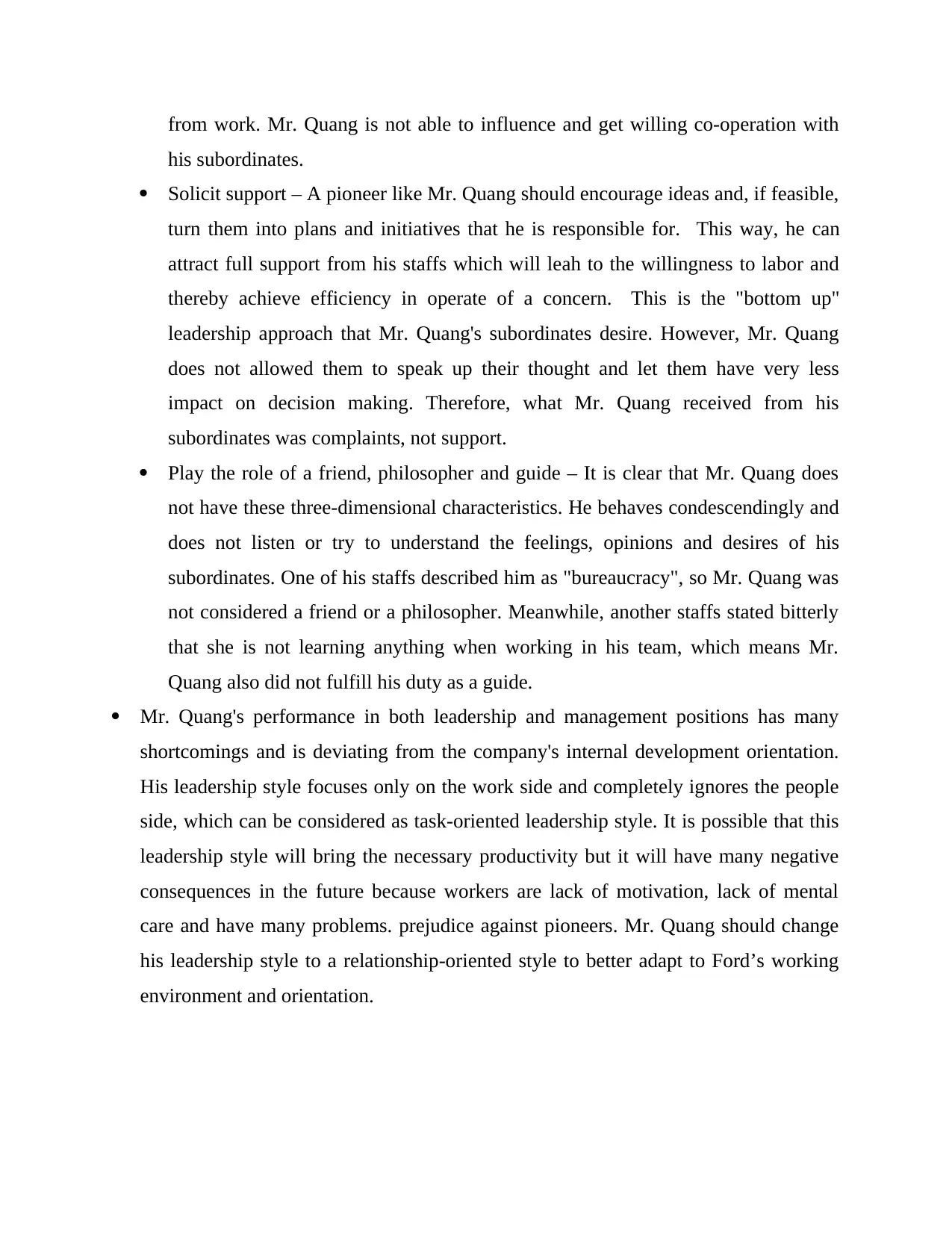
from work. Mr. Quang is not able to influence and get willing co-operation with
his subordinates.
Solicit support – A pioneer like Mr. Quang should encourage ideas and, if feasible,
turn them into plans and initiatives that he is responsible for. "This way, he can
attract full support from his staffs which will leah to the willingness to labor and
thereby achieve efficiency in operate of a concern." This is the "bottom up"
leadership approach that Mr. Quang's subordinates desire. However, Mr. Quang
does not allowed them to speak up their thought and let them have very less
impact on decision making. Therefore, what Mr. Quang received from his
subordinates was complaints, not support.
Play the role of a friend, philosopher and guide – It is clear that Mr. Quang does
not have these three-dimensional characteristics. He behaves condescendingly and
does not listen or try to understand the feelings, opinions and desires of his
subordinates. One of his staffs described him as "bureaucracy", so Mr. Quang was
not considered a friend or a philosopher. Meanwhile, another staffs stated bitterly
that she is not learning anything when working in his team, which means Mr.
Quang also did not fulfill his duty as a guide.
Mr. Quang's performance in both leadership and management positions has many
shortcomings and is deviating from the company's internal development orientation.
His leadership style focuses only on the work side and completely ignores the people
side, which can be considered as task-oriented leadership style. It is possible that this
leadership style will bring the necessary productivity but it will have many negative
consequences in the future because workers are lack of motivation, lack of mental
care and have many problems. prejudice against pioneers. Mr. Quang should change
his leadership style to a relationship-oriented style to better adapt to Ford’s working
environment and orientation.
his subordinates.
Solicit support – A pioneer like Mr. Quang should encourage ideas and, if feasible,
turn them into plans and initiatives that he is responsible for. "This way, he can
attract full support from his staffs which will leah to the willingness to labor and
thereby achieve efficiency in operate of a concern." This is the "bottom up"
leadership approach that Mr. Quang's subordinates desire. However, Mr. Quang
does not allowed them to speak up their thought and let them have very less
impact on decision making. Therefore, what Mr. Quang received from his
subordinates was complaints, not support.
Play the role of a friend, philosopher and guide – It is clear that Mr. Quang does
not have these three-dimensional characteristics. He behaves condescendingly and
does not listen or try to understand the feelings, opinions and desires of his
subordinates. One of his staffs described him as "bureaucracy", so Mr. Quang was
not considered a friend or a philosopher. Meanwhile, another staffs stated bitterly
that she is not learning anything when working in his team, which means Mr.
Quang also did not fulfill his duty as a guide.
Mr. Quang's performance in both leadership and management positions has many
shortcomings and is deviating from the company's internal development orientation.
His leadership style focuses only on the work side and completely ignores the people
side, which can be considered as task-oriented leadership style. It is possible that this
leadership style will bring the necessary productivity but it will have many negative
consequences in the future because workers are lack of motivation, lack of mental
care and have many problems. prejudice against pioneers. Mr. Quang should change
his leadership style to a relationship-oriented style to better adapt to Ford’s working
environment and orientation.
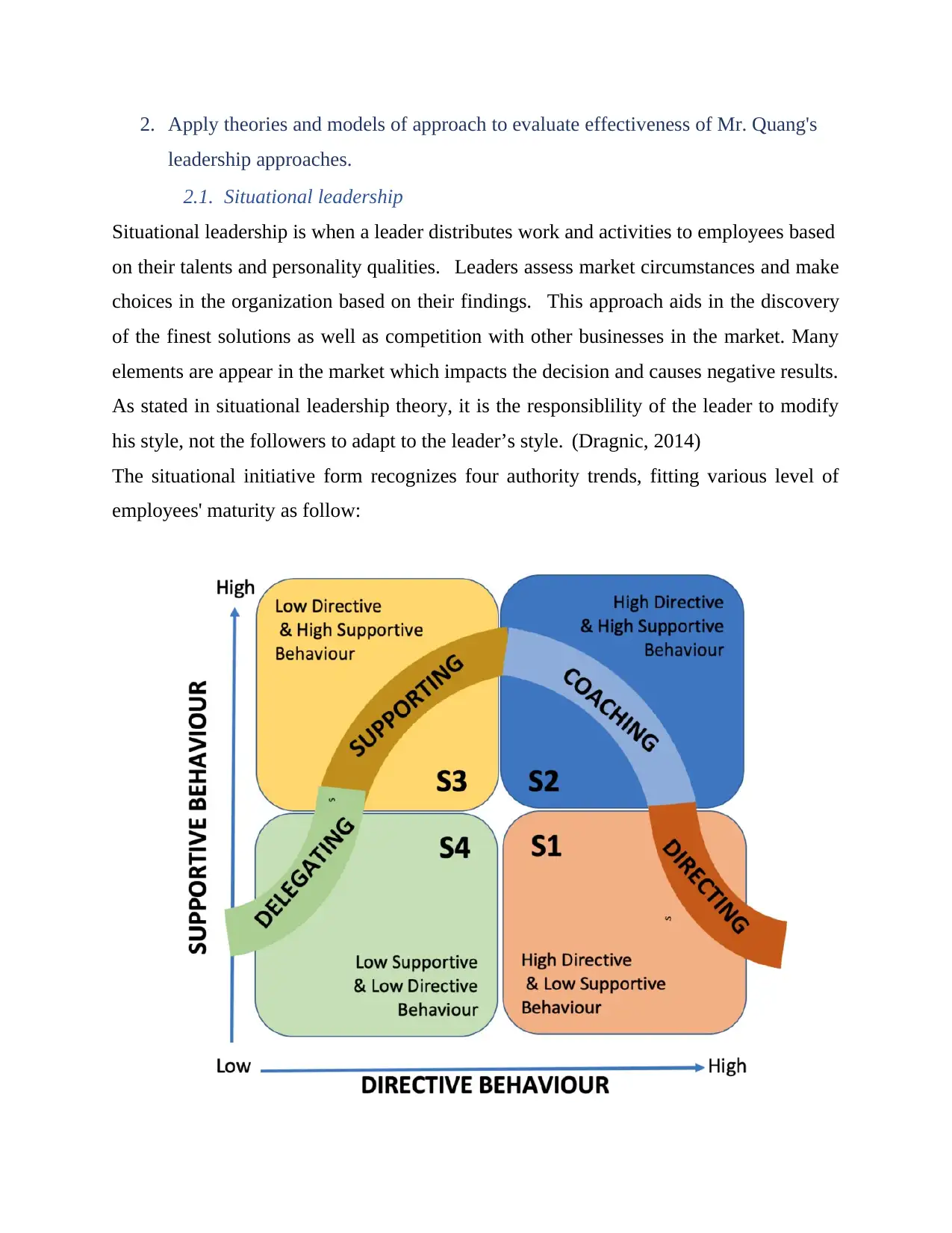
2. Apply.theories.and.models.of.approach.to.evaluate.effectiveness.of.Mr. Quang's
leadership.approaches.
2.1. Situational.leadership
Situational.leadership.is.when.a.leader.distributes.work.and.activities.to.employees.based
on their.talents.and.personality.qualities. "Leaders assess market circumstances and make
choices in the organization based on their findings." This approach aids in the discovery
of the finest solutions as well as competition with other businesses in the market. Many
elements are appear in the market which impacts the decision and causes negative results.
As stated in situational leadership theory, it is the responsiblility of the leader to modify
his style, not.the.followers.to.adapt.to.the.leader’s style."(Dragnic, 2014)
The situational initiative form recognizes four authority trends, fitting various level of
employees' maturity as follow:
leadership.approaches.
2.1. Situational.leadership
Situational.leadership.is.when.a.leader.distributes.work.and.activities.to.employees.based
on their.talents.and.personality.qualities. "Leaders assess market circumstances and make
choices in the organization based on their findings." This approach aids in the discovery
of the finest solutions as well as competition with other businesses in the market. Many
elements are appear in the market which impacts the decision and causes negative results.
As stated in situational leadership theory, it is the responsiblility of the leader to modify
his style, not.the.followers.to.adapt.to.the.leader’s style."(Dragnic, 2014)
The situational initiative form recognizes four authority trends, fitting various level of
employees' maturity as follow:
⊘ This is a preview!⊘
Do you want full access?
Subscribe today to unlock all pages.

Trusted by 1+ million students worldwide
1 out of 18
Related Documents
Your All-in-One AI-Powered Toolkit for Academic Success.
+13062052269
info@desklib.com
Available 24*7 on WhatsApp / Email
![[object Object]](/_next/static/media/star-bottom.7253800d.svg)
Unlock your academic potential
Copyright © 2020–2025 A2Z Services. All Rights Reserved. Developed and managed by ZUCOL.





